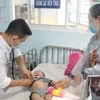Hanoi (VNA) - Duong Thi Hong, Deputy Director of the National Institute of Hygiene and Epidemiology, spoke to Vietnam News Agency about the success of the National Expanded Programme on Immunisation since its launch in 1985.
Q: Could you please elaborate on the effectiveness of the 10 vaccines used in the National Expanded Programme on Immunisation?
A: There are 10 kinds of vaccines which have been introduced in our national Expanded Programme on Immunisation (EPI), of which 10 vaccines are manufactured in Vietnam. They are tuberculosis, diptheria, whooping cough, tetanus, measles, poliomyelitis, hepatatis B, Japanese meningitis B, cholera and typhoid.
All the 12 vaccines, either imported or produced at home, are strictly tested before receiving licences for use.
Since 1985, Vietnam has used Vietnamese-made vaccines in the EPI. Since the year 2000, Vietnam has successfully eliminated poliomyelities and five years later tetanus has been completely erased. Other infectious diseases like whooping cough, diphtheria, Japanese meningitis and measles have been reduced considerably thanks to the EPI.
More recently, WHO granted Vietnam the NRA certificate, which is an acknowledgement of the high quality of vaccines manufactured in Vietnam.
Q: In your opinion, what are the challenges Vietnam is facing during the current implementation of the EPI?
A: Though the coverage of the EPI has reached over 90 percent, many children living in remote areas have not received all the required inoculation shots in the programme.
In addition, with the graduated phasing out of foreign aid, the EPI should be given special treatment from the central and local governments to ensure all children under six years old are immunised against 12 deadly diseases with high quality vaccines.
Last but not least, vaccines against some serious infectious diseases including the vaccine against Rota virus or the Pneumuccocal Conjugate Vaccine (PCV) have not yet been used in the EPI.
Q: Many parents living in major cities like Hanoi and Ho Chi Minh believe that vaccines provided in the paid service have better quality than those in the EPI. Do you think there is a difference in the quality and effectiveness of the vaccines used in the two systems?
A: I just want to say vaccines used in the EPI or those used in the paid service must go through a strict testing and verification process by concerned authorities. The only difference is that vaccines used in the EPI are free of charge. Every year, the government has to spend a huge sum of money from the State budget to buy vaccines for the EPI and for pregnant women.
Annually, the EPI gives inoculations for more than 1.5 million children while the paid service vaccines only provides for about 5 percent of children under 12 months.
Q: What will be the key targets set for the EPI in 2016?
A: We set the target to achieve coverage of over 90 percent of children under 12 months old to receive eight types of core vaccines; for children under 18 months old, we want more than 90 percent of them to get the fourth shot for whooping cough, diphtheria, tetanus, measles – rubella.
We also set the target to give more than 90 percent of children in the age group from 1 to 5 to receive inoculations against Japanese encephalitis vaccine; and all newborn babies receive one shot of Hepatitis B within 24 hours after birth.
Last but not least, Vietnam will join the world to eliminate polio among children. Also in 2016, Vietnam will start to give IPV while continuing to give children three doses of oral vaccine against polio.-VNA
























